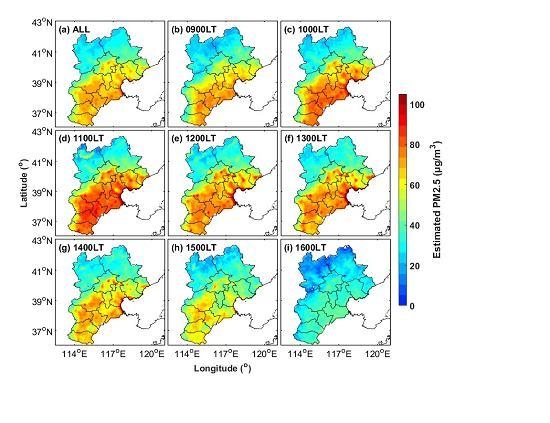Deriving Hourly PM2.5 Concentrations from Himawari-8 AODs over Beijing–Tianjin–Hebei in China
Abstract
1. Introduction
2. Study Area and Datasets
2.1. Study Area
2.2. Datasets
3. Method
3.1. Evaluation Method of the Himawari-8 AOD
3.2. PM2.5 Estimated Model
4. Results
4.1. Evaluation of Himawari-8 AOD
4.2. Verification of Estimated PM2.5
4.3. Spatial Distribution of PM2.5
5. Discussion
6. Conclusions
Acknowledgments
Author Contributions
Conflicts of Interest
References
- Ma, X.; Wang, J.; Yu, F.; Jia, H.; Hu, Y. Can MODIS AOD be employed to derive PM2.5 in Beijing-Tianjin-Hebei over China? Atmos. Res. 2016, 181, 250–256. [Google Scholar] [CrossRef]
- Zhang, T.; Gong, W.; Wang, W.; Ji, Y.; Zhu, Z.; Huang, Y. Ground level PM2.5 estimates over China using satellite-based geographically weighted regression (GWR) models are improved by including NO2 and enhanced vegetation index (EVI). Int. J. Environ. Res. Public Health 2016, 13, 1215. [Google Scholar] [CrossRef] [PubMed]
- Pope, C.A. Epidemiology of fine particulate air pollution and human health: biologic mechanisms and who’s at risk? Environ. Health Perspect. 2000, 108, 713–723. [Google Scholar] [CrossRef] [PubMed]
- Zhang, Y.-L.; Cao, F. Fine particulate matter (PM2.5) in China at a city level. Sci. Rep. 2015, 5. [Google Scholar] [CrossRef] [PubMed]
- Lee, H.J.; Chatfield, R.B.; Strawa, A.W. Enhancing the applicability of satellite remote sensing for PM2.5 estimation using MODIS deep blue AOD and land use regression in California, United States. Environ. Sci. Technol. 2016, 50, 6546–6555. [Google Scholar] [CrossRef] [PubMed]
- Wang, W.; Gong, W.; Mao, F.; Zhang, J. Long-term measurement for low-tropospheric water vapor and aerosol by Raman lidar in Wuhan. Atmosphere 2015, 6, 521–533. [Google Scholar] [CrossRef]
- Koelemeijer, R.B.A.; Homan, C.D.; Matthijsen, J. Comparison of spatial and temporal variations of aerosol optical thickness and particulate matter over Europe. Atmos. Environ. 2006, 40, 5304–5315. [Google Scholar] [CrossRef]
- Xin, J.; Zhang, Q.; Wang, L.; Gong, C.; Wang, Y.; Liu, Z.; Gao, W. The empirical relationship between the PM2.5 concentration and aerosol optical depth over the background of north China from 2009 to 2011. Atmos. Res. 2014, 138, 179–188. [Google Scholar] [CrossRef]
- Zou, B.; Chen, J.; Zhai, L.; Fang, X.; Zheng, Z. Satellite based mapping of ground PM2.5 concentration using generalized additive modeling. Remote Sens. 2017, 9, 1. [Google Scholar] [CrossRef]
- Chu, D.A.; Kaufman, Y.J.; Zibordi, G.; Chern, J.D.; Mao, J.; Li, C.; Holben, B.N. Global monitoring of air pollution over land from the earth observing system-terra moderate resolution imaging spectroradiometer (MODIS). J. Geophys. Res. Atmos. 2003, 108. [Google Scholar] [CrossRef]
- Gupta, P.; Christopher, S.A. Particulate matter air quality assessment using integrated surface, satellite, and meteorological products: Multiple regression approach. J. Geophys. Res. Atmos. 2009, 114. [Google Scholar] [CrossRef]
- Liu, Y.; Sarnat, J.A.; Kilaru, V.; Jacob, D.J.; Koutrakis, P. Estimating ground-level PM2.5 in the Eastern United States using satellite remote sensing. Environ. Sci. Technol. 2005, 39, 3269–3278. [Google Scholar] [CrossRef] [PubMed]
- Chen, Q.-X.; Yuan, Y.; Huang, X.; Jiang, Y.-Q.; Tan, H.-P. Estimation of surface-level PM2.5 concentration using aerosol optical thickness through aerosol type analysis method. Atmos. Environ. 2017, 159, 26–33. [Google Scholar] [CrossRef]
- Guo, J.; Xia, F.; Zhang, Y.; Liu, H.; Li, J.; Lou, M.; He, J.; Yan, Y.; Wang, F.; Min, M.; et al. Impact of diurnal variability and meteorological factors on the PM2.5-AOD relationship: Implications for PM2.5 remote sensing. Environ. Pollut. 2017, 221, 94–104. [Google Scholar] [CrossRef] [PubMed]
- Stafoggia, M.; Schwartz, J.; Badaloni, C.; Bellander, T.; Alessandrini, E.; Cattani, G.; de’ Donato, F.; Gaeta, A.; Leone, G.; Lyapustin, A.; et al. Estimation of daily PM10 concentrations in Italy (2006–2012) using finely resolved satellite data, land use variables and meteorology. Environ. Int. 2017, 99, 234–244. [Google Scholar] [CrossRef] [PubMed]
- Lee, H.J.; Liu, Y.; Coull, B.A.; Schwartz, J.; Koutrakis, P. A novel calibration approach of MODIS AOD data to predict PM2.5 concentrations. Atmos. Chem. Phys. Discuss. 2011. [Google Scholar] [CrossRef]
- Xie, Y.; Wang, Y.; Zhang, K.; Dong, W.; Lv, B.; Bai, Y. Daily estimation of ground-level PM2.5 concentrations over Beijing using 3 km resolution MODIS AOD. Environ. Sci. Technol. 2015, 49, 12280–12288. [Google Scholar] [CrossRef] [PubMed]
- Zheng, Y.; Zhang, Q.; Liu, Y.; Geng, G.; He, K. Estimating ground-level PM2.5 concentrations over three megalopolises in China using satellite-derived aerosol optical depth measurements. Atmos. Environ. 2016, 124 Pt B, 232–242. [Google Scholar] [CrossRef]
- Li, C.; Hsu, N.C.; Tsay, S.-C. A study on the potential applications of satellite data in air quality monitoring and forecasting. Atmos. Environ. 2011, 45, 3663–3675. [Google Scholar] [CrossRef]
- Zou, B.; Pu, Q.; Bilal, M.; Weng, Q.; Zhai, L.; Nichol, J.E. High-resolution satellite mapping of fine particulates based on geographically weighted regression. IEEE Geosci. Remote Sens. Lett. 2016, 13, 495–499. [Google Scholar] [CrossRef]
- Remer, L.A.; Kaufman, Y.; Tanré, D.; Mattoo, S.; Chu, D.; Martins, J.; Li, R.-R.; Ichoku, C.; Levy, R.; Kleidman, R. The MODIS aerosol algorithm, products, and validation. J. Atmos. Sci. 2005, 62, 947–973. [Google Scholar] [CrossRef]
- Wang, W.; Mao, F.; Pan, Z.; Du, L.; Gong, W. Validation of VIIRS AOD through a comparison with a sun photometer and MODIS AODS over Wuhan. Remote Sens. 2017, 9, 403. [Google Scholar] [CrossRef]
- Emili, E.; Popp, C.; Petitta, M.; Riffler, M.; Wunderle, S.; Zebisch, M. PM10 remote sensing from geostationary SEVIRI and polar-orbiting MODIS sensors over the complex terrain of the European Alpine region. Remote Sens. Environ. 2010, 114, 2485–2499. [Google Scholar] [CrossRef]
- Bessho, K.; Date, K.; Hayashi, M.; Ikeda, A.; Imai, T.; Inoue, H.; Kumagai, Y.; Miyakawa, T.; Murata, H.; Ohno, T.; et al. An introduction to Himawari-8/9—Japan’s new-generation geostationary meteorological satellites. J. Meteorol. Soc. Jpn. Ser. II 2016, 94, 151–183. [Google Scholar] [CrossRef]
- Yumimoto, K.; Nagao, T.M.; Kikuchi, M.; Sekiyama, T.T.; Murakami, H.; Tanaka, T.Y.; Ogi, A.; Irie, H.; Khatri, P.; Okumura, H.; et al. Aerosol data assimilation using data from Himawari-8, a next-generation geostationary meteorological satellite. Geophys. Res. Lett. 2016, 43, 5886–5894. [Google Scholar] [CrossRef]
- Shang, H.; Chen, L.; Letu, H.; Zhao, M.; Li, S.; Bao, S. Development of a daytime cloud and haze detection algorithm for Himawari-8 satellite measurements over central and eastern China. J. Geophys. Res. Atmos. 2017. [Google Scholar] [CrossRef]
- Liu, H.; Remer, L.A.; Huang, J.; Huang, H.-C.; Kondragunta, S.; Laszlo, I.; Oo, M.; Jackson, J.M. Preliminary evaluation of S-NPP VIIRS aerosol optical thickness. J. Geophys. Res. Atmos. 2014, 119, 3942–3962. [Google Scholar] [CrossRef]
- Kurihara, Y.; Murakami, H.; Kachi, M. Sea surface temperature from the new Japanese geostationary meteorological Himawari-8 satellite. Geophys. Res. Lett. 2016, 43, 1234–1240. [Google Scholar] [CrossRef]
- Dubovik, O.; Smirnov, A.; Holben, B.N.; King, M.D.; Kaufman, Y.J.; Eck, T.F.; Slutsker, I. Accuracy assessments of aerosol optical properties retrieved from aerosol robotic network (AERONET) sun and sky radiance measurements. J. Geophys. Res. Atmos. 2000, 105, 9791–9806. [Google Scholar] [CrossRef]
- Xu, J.W.; Martin, R.V.; van Donkelaar, A.; Kim, J.; Choi, M.; Zhang, Q.; Geng, G.; Liu, Y.; Ma, Z.; Huang, L.; et al. Estimating ground-level PM2.5 in Eastern China using aerosol optical depth determined from the goci satellite instrument. Atmos. Chem. Phys. 2015, 15, 13133–13144. [Google Scholar] [CrossRef]
- Molteni, F.; Buizza, R.; Palmer, T.N.; Petroliagis, T. The ECMWF ensemble prediction system: Methodology and validation. Q. J. R. Meteorol. Soc. 1996, 122, 73–119. [Google Scholar] [CrossRef]
- Levy, R.C.; Mattoo, S.; Munchak, L.A.; Remer, L.A.; Sayer, A.M.; Patadia, F.; Hsu, N.C. The collection 6 MODIS aerosol products over land and ocean. Atmos. Meas. Tech. 2013, 6, 2989–3034. [Google Scholar] [CrossRef]
- Xiao, Q.; Zhang, H.; Choi, M.; Li, S.; Kondragunta, S.; Kim, J.; Holben, B.; Levy, R.C.; Liu, Y. Evaluation of VIIRS, GOCI, and MODIS collection 6 aod retrievals against ground sunphotometer observations over east Asia. Atmos. Chem. Phys. 2016, 16, 20709–20741. [Google Scholar] [CrossRef]
- Nichol, J.; Bilal, M. Validation of MODIS 3 km resolution aerosol optical depth retrievals over Asia. Remote Sens. 2016, 8, 328. [Google Scholar] [CrossRef]
- Huang, J.; Kondragunta, S.; Laszlo, I.; Liu, H.; Remer, L.A.; Zhang, H.; Superczynski, S.; Ciren, P.; Holben, B.N.; Petrenko, M. Validation and expected error estimation of Suomi-NPP VIIRS aerosol optical thickness and angström exponent with aeronet. J. Geophys. Res. Atmos. 2016, 121, 7139–7160. [Google Scholar] [CrossRef]
- Ma, Z.; Liu, Y.; Zhao, Q.; Liu, M.; Zhou, Y.; Bi, J. Satellite-derived high resolution PM2.5 concentrations in Yangtze River delta region of China using improved linear mixed effects model. Atmos. Environ. 2016, 133, 156–164. [Google Scholar] [CrossRef]
- Pinheiro, J.C.; Bates, D.M. Mixed-Effects Models in S and S-PLUS; Springer: Berlin/Heidelberg, Germany, 2004. [Google Scholar]
- Li, S.; Joseph, E.; Min, Q. Remote sensing of ground-level PM2.5 combining AOD and backscattering profile. Remote Sens. Environ. 2016, 183, 120–128. [Google Scholar] [CrossRef]
- Zhang, Y.; Li, Z. Remote sensing of atmospheric fine particulate matter (PM2.5) mass concentration near the ground from satellite observation. Remote Sens. Environ. 2015, 160, 252–262. [Google Scholar] [CrossRef]
- Chu, D.A.; Ferrare, R.; Szykman, J.; Lewis, J.; Scarino, A.; Hains, J.; Burton, S.; Chen, G.; Tsai, T.; Hostetler, C.; et al. Regional characteristics of the relationship between columnar aod and surface PM2.5: Application of lidar aerosol extinction profiles over Baltimore–Washington corridor during discover-AQ. Atmos. Environ. 2015, 101, 338–349. [Google Scholar] [CrossRef]
- Barnaba, F.; Putaud, J.P.; Gruening, C.; dell’Acqua, A.; Dos Santos, S. Annual cycle in co-located in situ, total-column, and height-resolved aerosol observations in the Po Valley (Italy): Implications for ground-level particulate matter mass concentration estimation from remote sensing. J. Geophys. Res. Atmos. 2010, 115. [Google Scholar] [CrossRef]
- Song, W.; Jia, H.; Huang, J.; Zhang, Y. A satellite-based geographically weighted regression model for regional PM2.5 estimation over the Pearl river delta region in China. Remote Sens. Environ. 2014, 154, 1–7. [Google Scholar] [CrossRef]
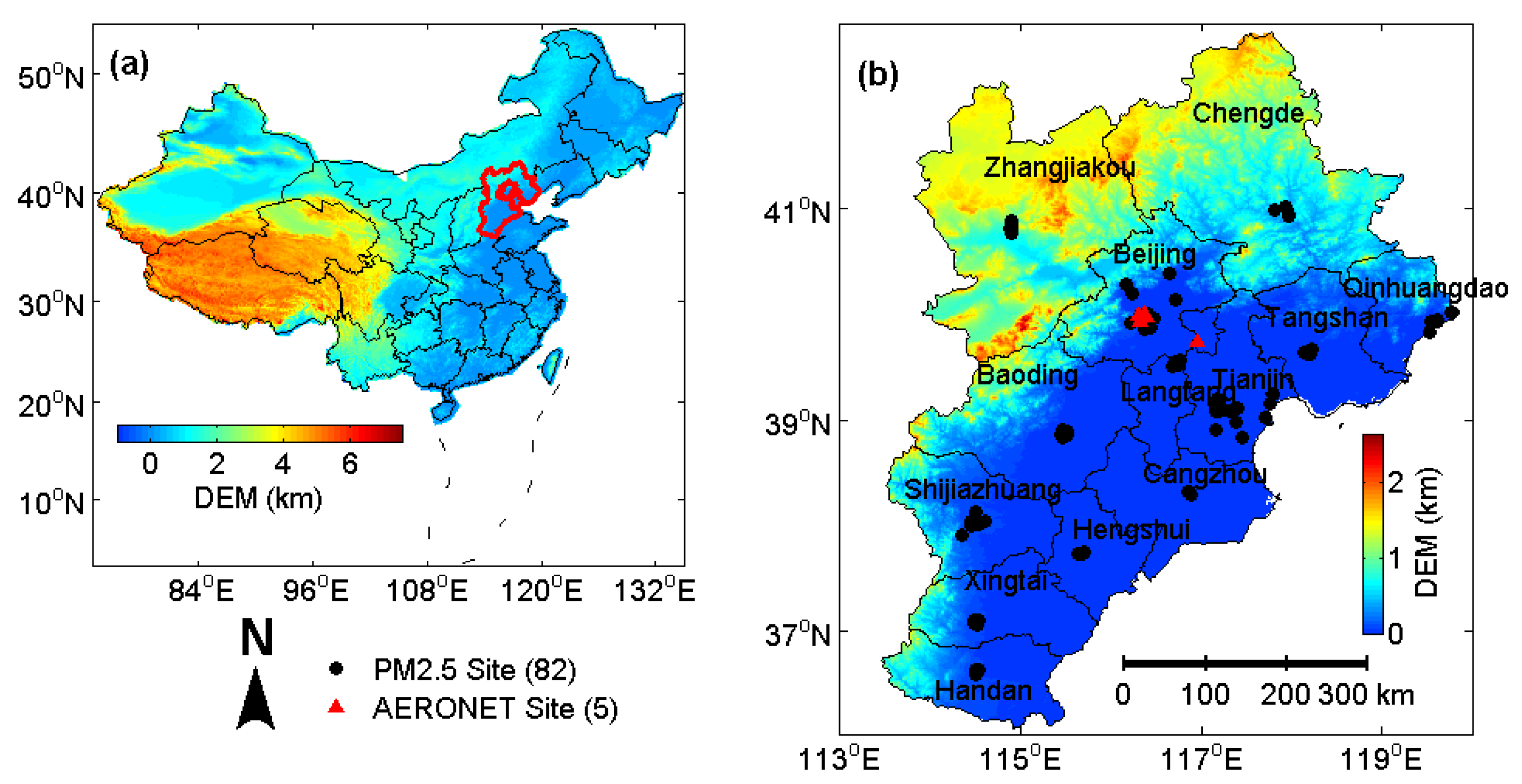
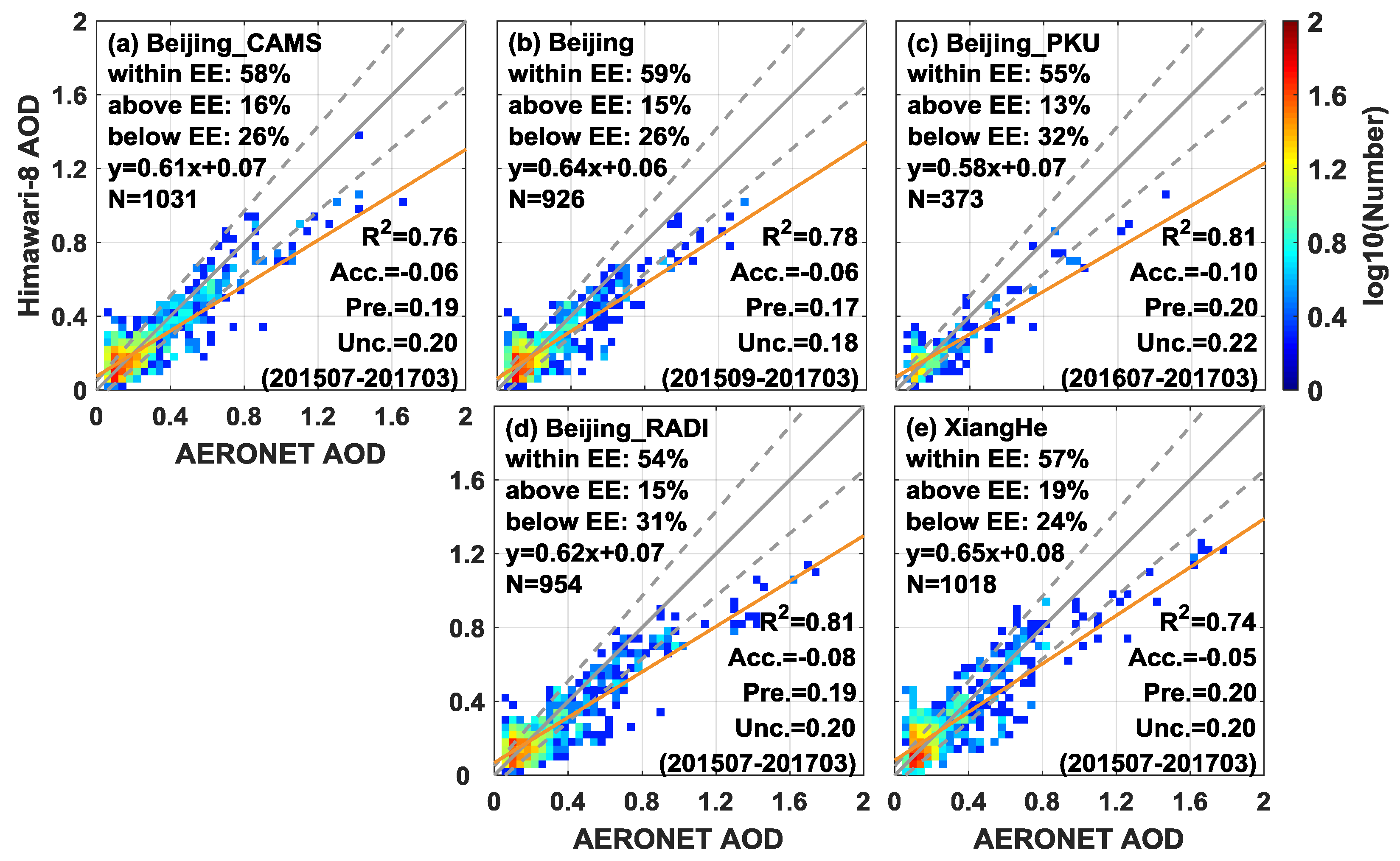
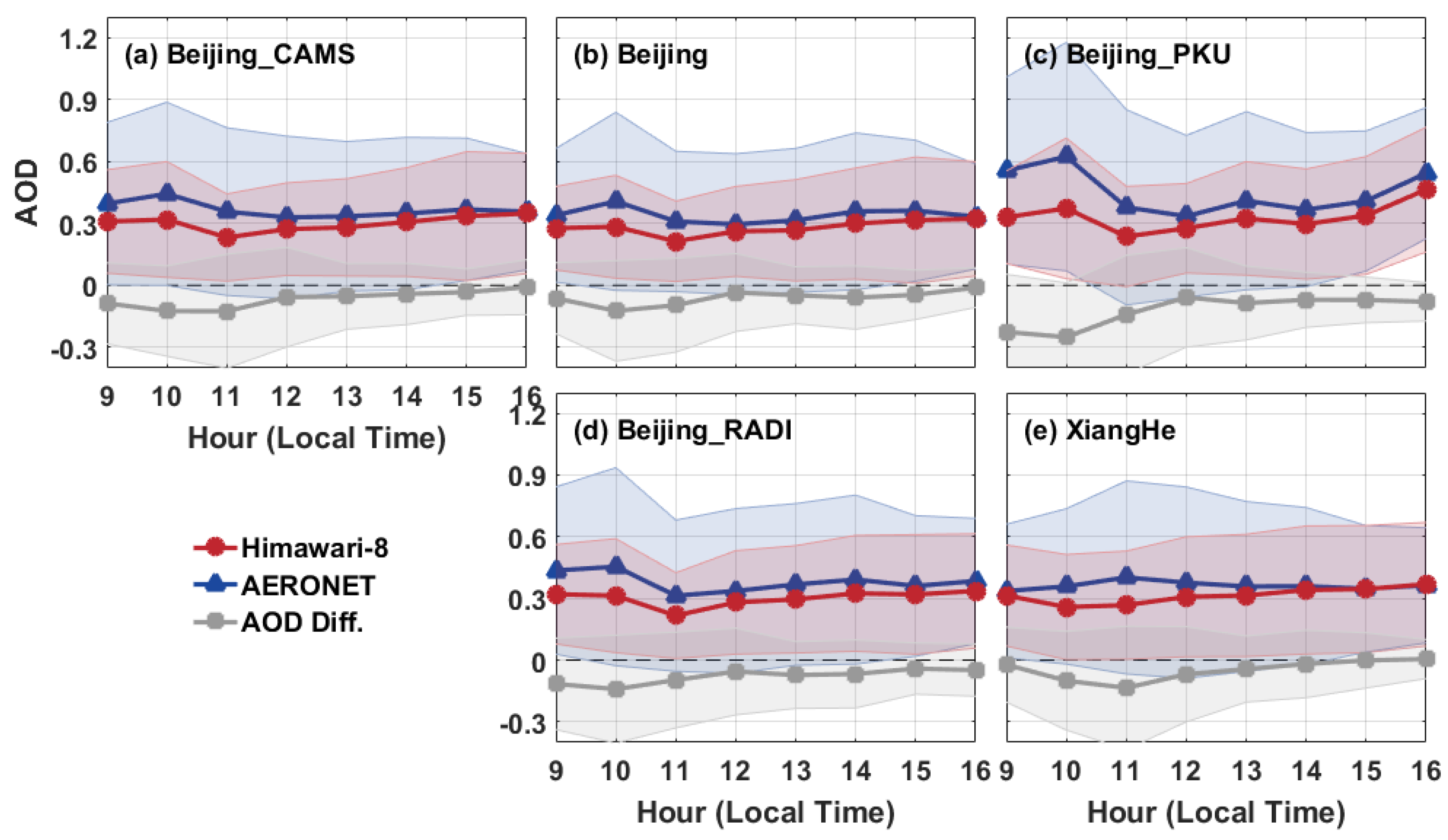
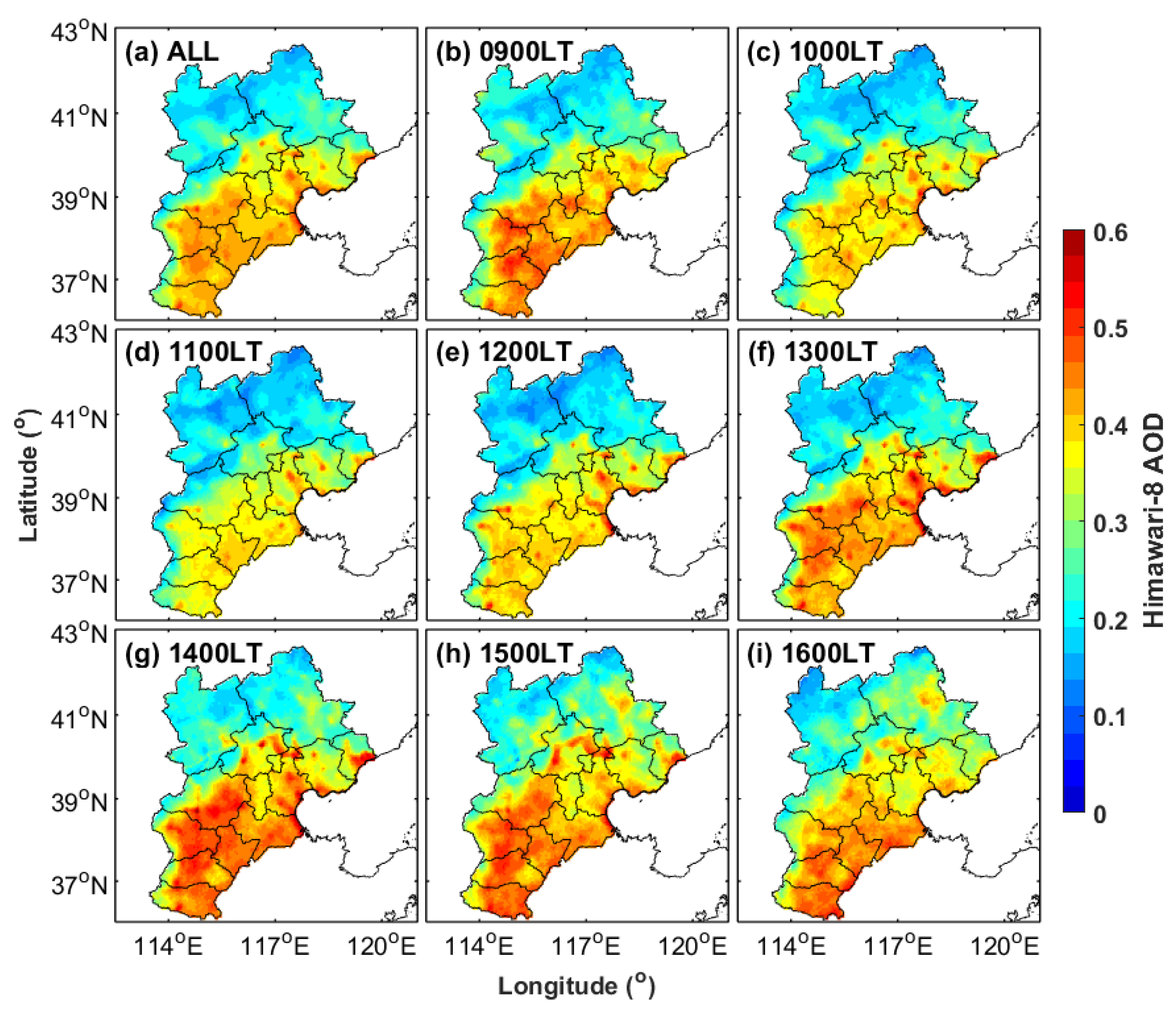
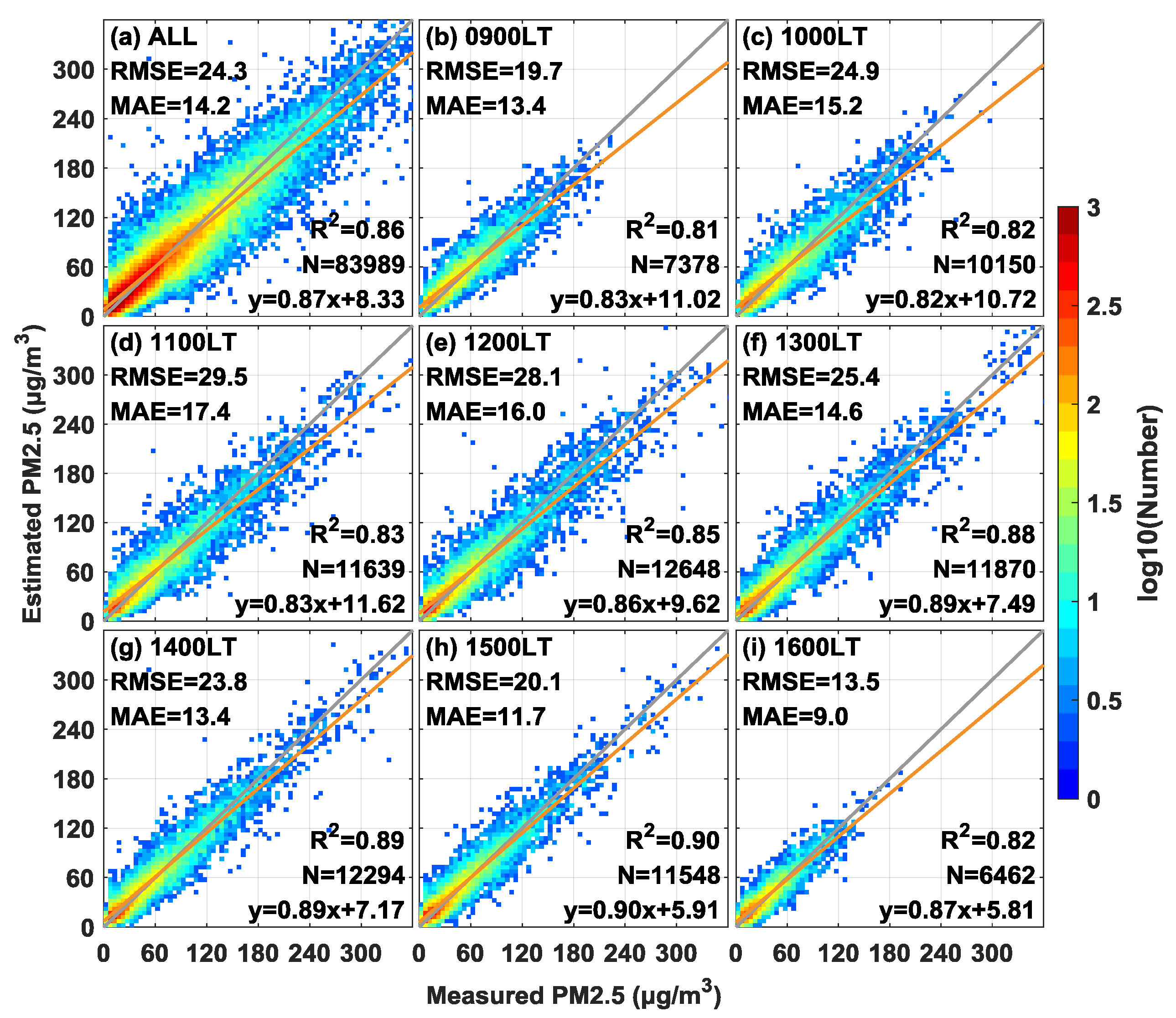
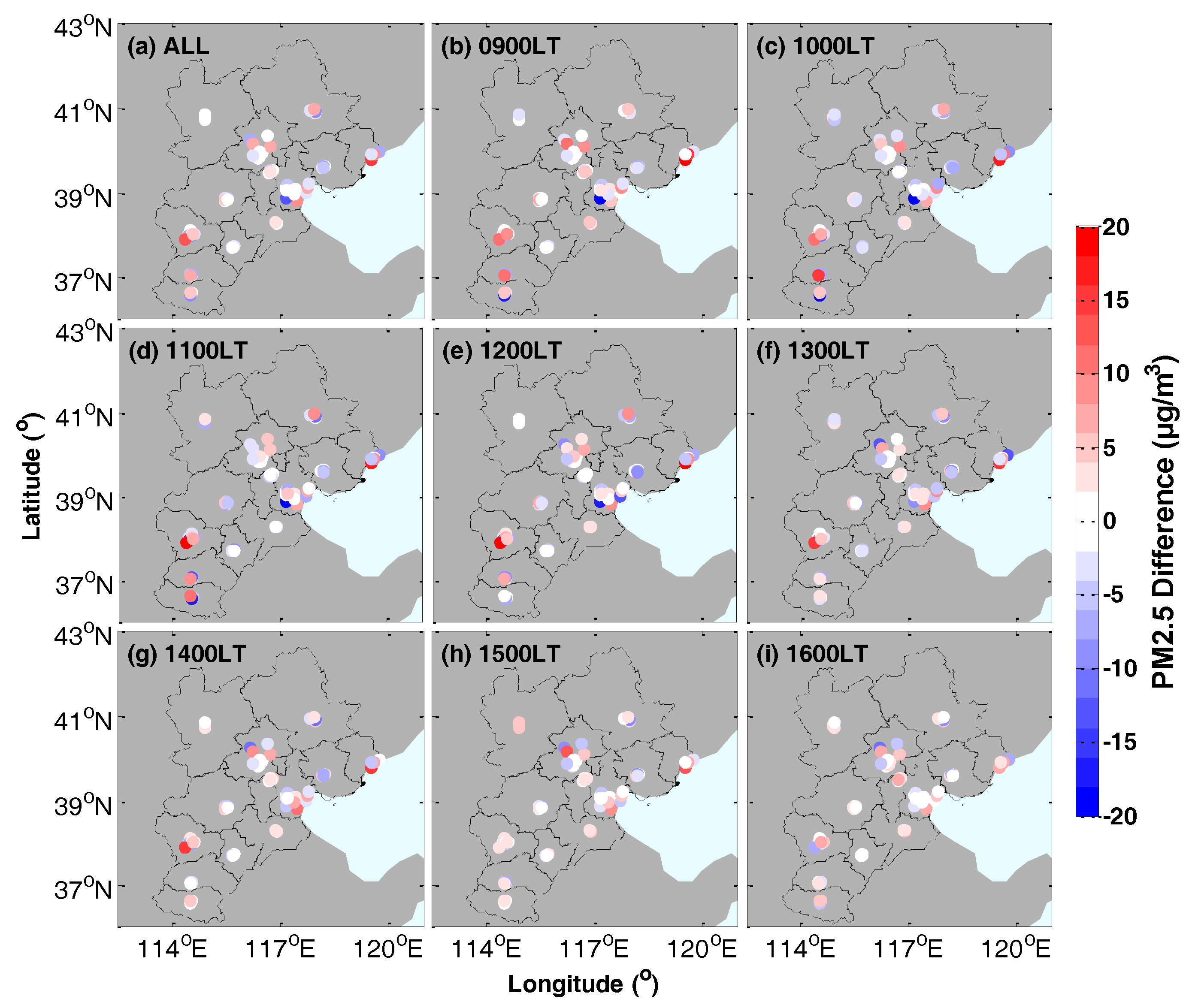

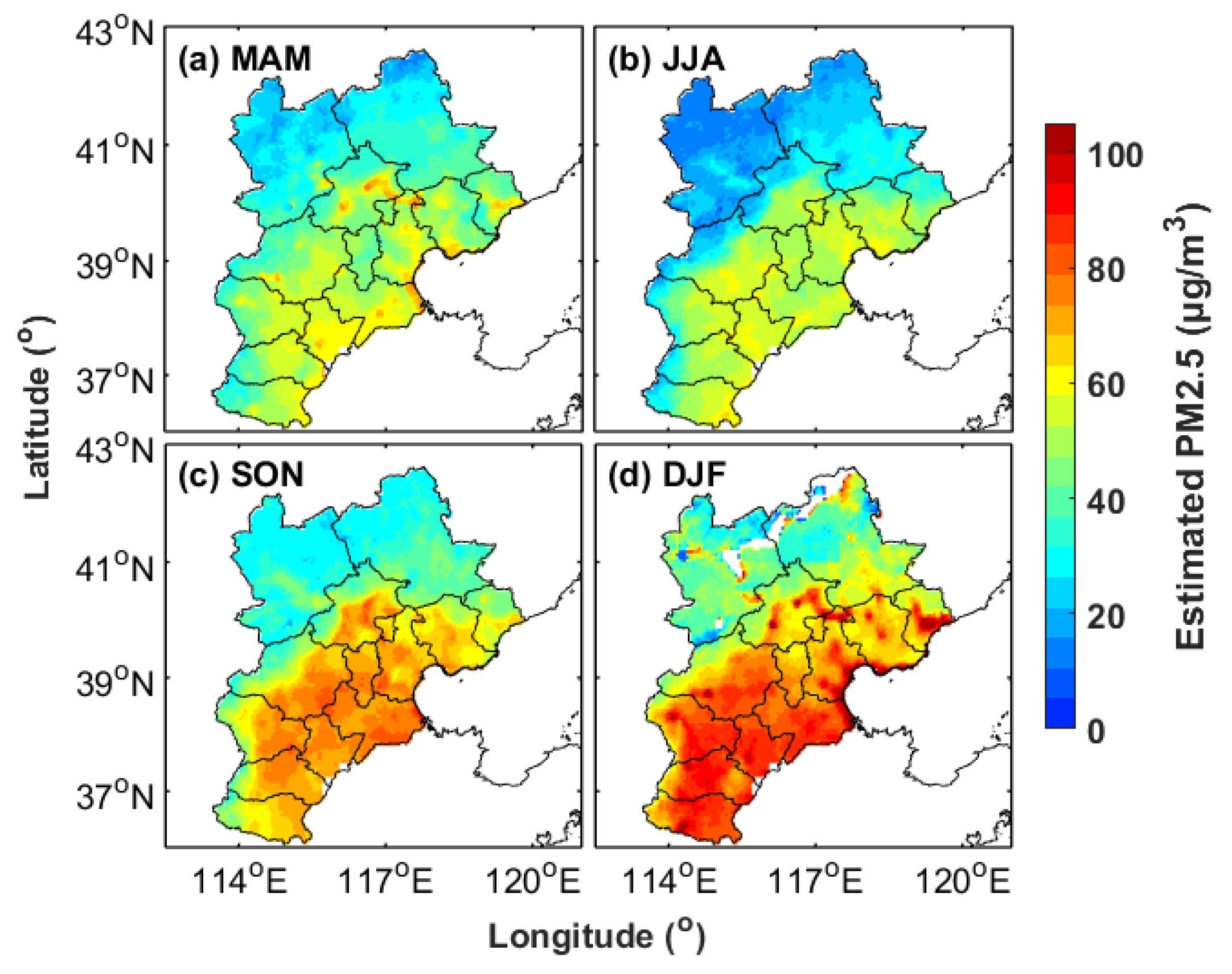
| Dataset | Variable | Unit | Temporal Resolution | Spatial Resolution | Source |
|---|---|---|---|---|---|
| PM2.5 | PM2.5 | μg/m3 | 1 h | Site | CEMC |
| AOD | Ground AOD | Unitless | ~15 min | Site | AERONET |
| Satellite AOD | Unitless | 1 h | 0.18 | Himawari-8 | |
| Meteorological Factors | RH | % | 6 h | 0.125° | ECMWF |
| BLH | m | 3 h | 0.125° | ||
| Land | NDVI | Unitless | 16 days | 0.05° | MODIS |
| DEM | m | not available | 90 m | NASA |
| Site | N | Accuracy | Precision | Uncertainty | R2 | % Above/Within/Below EE |
|---|---|---|---|---|---|---|
| Beijing_CAMS | 1031 | –0.06 | 0.19 | 0.20 | 0.76 | 16/58/26 |
| Beijing | 926 | –0.06 | 0.17 | 0.18 | 0.78 | 15/59/26 |
| Beijing_PKU | 373 | –0.10 | 0.20 | 0.22 | 0.81 | 13/55/32 |
| Beijing_RADI | 954 | –0.08 | 0.19 | 0.20 | 0.81 | 15/54/31 |
| XiangHe | 1018 | –0.05 | 0.20 | 0.20 | 0.74 | 19/57/24 |
| ID | Predictor(s) | Group Variable | AIC | R2 | RMSE | MAE |
|---|---|---|---|---|---|---|
| Test 1 | AOD | Day | 859,622.35 | 0.64 | 39.3 | 25.0 |
| Test 2 | AOD | Hour | 845,625.88 | 0.74 | 33.1 | 20.4 |
| Test 3 | AOD; NDVI | Hour | 845,589.45 | 0.74 | 33.1 | 20.4 |
| Test 4 | AOD; RH | Hour | 845,569.14 | 0.74 | 33.1 | 20.4 |
| Test 5 | AOD; BLH | Hour | 845,488.73 | 0.74 | 33.1 | 20.5 |
| Test 6 | AOD; DEM | Hour | 844,323.77 | 0.74 | 32.9 | 20.4 |
| Test 7 | Model 1 without AOD | Hour | 876,681.07 | 0.59 | 41.4 | 26.7 |
| Test 8 | Model 1 without | Hour | 852,313.20 | 0.70 | 35.8 | 22.6 |
| Test 9 | Model 1 | Hour | 844,079.65 | 0.74 | 32.8 | 20.4 |
| Test 10 | Model 2 without AOD | Hour; location | 815,754.76 | 0.83 | 26.6 | 15.8 |
| Test 11 | Model 2 | Hour; location | 809,533.48 | 0.93 | 17.1 | 10.1 |
| Term | Model 1 | Model 2 | ||||
|---|---|---|---|---|---|---|
| F-Test | p-Value | Beta | F-Test | p-Value | Beta | |
| Intercept | 767.6983 | <0.01 | 39.43 | 2.0496 × 103 | <0.01 | 54.44 |
| AOD | 1.2631 × 103 | <0.01 | 96.38 | 4.9156 × 103 | <0.01 | 104.34 |
| RH | 100.7208 | <0.01 | −0.15 | 38.2626 | <0.01 | 0.11 |
| DEM | 1.2633 × 103 | <0.01 | −0.03 | 326.3786 | <0.01 | −0.02 |
| BLH | 216.8013 | <0.01 | −0.01 | 1.7214 × 103 | <0.01 | −0.02 |
| NDVI | 2.5560 | 0.11 | −3.06 | 339.0167 | <0.01 | −28.91 |
| Model 1 | Model 2 | |||||
|---|---|---|---|---|---|---|
| Estimate | 37.03 | 124.64 | 33.76 | 41.02 | 112.90 | 19.84 |
| Lower | 35.68 | 120.39 | 33.59 | 39.97 | 109.81 | 19.72 |
| Upper | 38.42 | 129.04 | 33.92 | 42.09 | 116.08 | 19.95 |
| Model | N | Site Cross-Validation | 10-Fold Cross-Validation | ||||
|---|---|---|---|---|---|---|---|
| R2 | RMSE | MAE | R2 | RMSE | MAE | ||
| Model 1 | 83,989 | 0.73 | 34.4 | 21.7 | 0.73 | 34.5 | 21.7 |
| Model 2 | 83,989 | 0.87 | 24.1 | 14.0 | 0.86 | 24.5 | 14.2 |
| Local Time | N | R2 | Estimated PM2.5 | Measured PM2.5 | PM2.5 Bias |
|---|---|---|---|---|---|
| ALL | 83,989 | 0.86 | 61.6 ± 61.4 | 61.5 ± 65.8 | 0.1 ± 24.3 |
| 0900 | 7378 | 0.81 | 58.6 ± 41.5 | 57.6 ± 45.2 | 1.1 ± 19.7 |
| 1000 | 10,150 | 0.82 | 63.5 ± 53.2 | 64.5 ± 58.9 | –1.0 ± 24.9 |
| 1100 | 11,639 | 0.83 | 71.0 ± 65.2 | 71.7 ± 71.8 | –0.8 ± 29.5 |
| 1200 | 12,648 | 0.85 | 66.9 ± 67.1 | 67.0 ± 72.3 | –0.1 ± 28.1 |
| 1300 | 11,870 | 0.88 | 66.7 ± 69.6 | 66.6 ± 73.4 | 0.1 ± 25.4 |
| 1400 | 12,294 | 0.89 | 62.9 ± 67.5 | 62.3 ± 71.0 | 0.6 ± 23.8 |
| 1500 | 11,548 | 0.90 | 54.8 ± 60.6 | 54.1 ± 63.8 | 0.6 ± 20.1 |
| 1600 | 6462 | 0.82 | 35.3 ± 30.3 | 34.0 ± 31.7 | 1.3 ± 13.4 |
| Local Time | Himawari-8 AOD | Estimated PM2.5 (μg/m3) |
|---|---|---|
| ALL | 0.32 ± 0.27 | 58.2 ± 52.7 |
| 0900 | 0.33 ± 0.25 | 52.6 ± 38.0 |
| 1000 | 0.31 ± 0.26 | 59.7 ± 47.6 |
| 1100 | 0.30 ± 0.26 | 65.5 ± 54.6 |
| 1200 | 0.32 ± 0.27 | 61.3 ± 56.8 |
| 1300 | 0.34 ± 0.28 | 62.2 ± 59.9 |
| 1400 | 0.37 ± 0.30 | 59.5 ± 58.1 |
| 1500 | 0.38 ± 0.31 | 52.3 ± 50.9 |
| 1600 | 0.37 ± 0.29 | 35.2 ± 26.9 |
| MAM | 0.30 ± 0.26 | 46.0 ± 38.4 |
| JJA | 0.38 ± 0.32 | 42.5 ± 29.8 |
| SON | 0.36 ± 0.31 | 57.8 ± 50.7 |
| DJF | 0.26 ± 0.23 | 71.5 ± 70.1 |
© 2017 by the authors. Licensee MDPI, Basel, Switzerland. This article is an open access article distributed under the terms and conditions of the Creative Commons Attribution (CC BY) license (http://creativecommons.org/licenses/by/4.0/).
Share and Cite
Wang, W.; Mao, F.; Du, L.; Pan, Z.; Gong, W.; Fang, S. Deriving Hourly PM2.5 Concentrations from Himawari-8 AODs over Beijing–Tianjin–Hebei in China. Remote Sens. 2017, 9, 858. https://doi.org/10.3390/rs9080858
Wang W, Mao F, Du L, Pan Z, Gong W, Fang S. Deriving Hourly PM2.5 Concentrations from Himawari-8 AODs over Beijing–Tianjin–Hebei in China. Remote Sensing. 2017; 9(8):858. https://doi.org/10.3390/rs9080858
Chicago/Turabian StyleWang, Wei, Feiyue Mao, Lin Du, Zengxin Pan, Wei Gong, and Shenghui Fang. 2017. "Deriving Hourly PM2.5 Concentrations from Himawari-8 AODs over Beijing–Tianjin–Hebei in China" Remote Sensing 9, no. 8: 858. https://doi.org/10.3390/rs9080858
APA StyleWang, W., Mao, F., Du, L., Pan, Z., Gong, W., & Fang, S. (2017). Deriving Hourly PM2.5 Concentrations from Himawari-8 AODs over Beijing–Tianjin–Hebei in China. Remote Sensing, 9(8), 858. https://doi.org/10.3390/rs9080858







